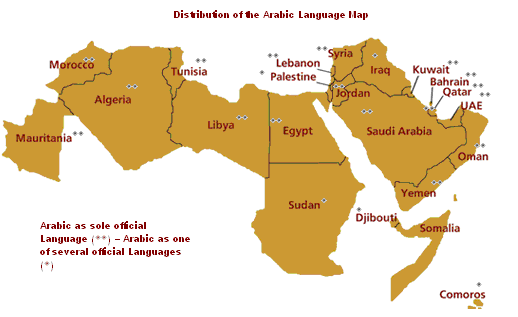Lesson (1) The Arabic Language: History and Facts
The Arabic Language historically wise flourished with the rise of Islam as a major world religion as it is the Language of the Holy Quran - the Holy book of Islam. It is the first Language in Muslim States throughout the world. However, Arabic increased in importance since the World War II after the independence of the Arab Countries in the Arab World 1 besides the evolving Near East international affairs that results in a pushing forward need for the foreigners in the West to be familiarized with this classy Language of culture and civilization.
Arabic belongs to the Semitic Group of Languages 2 that is spoken in 25 countries 3 . Now, Arabic can be classified into two Classes of four groups:
1st Class Written-wise
Group 1: Classical Written Arabic
- Classical Written Arabic refers to the Arabic Language since the 6th AD or before then.
- Originated in Saudi Arabia in pre-Islamic times.
- Classical Arabic changed over centuries.
- The most accurate example that illustrates it is clearly seen in the Language of the Quran and the Language of writers like Al-Mutanabbi 4 and others.
Group 2: Modern Literary Written Arabic
- It differs from Classical Written Arabic.
- Changes in this group is similar to the changes experienced with the European Languages - the difference between Chaucer's 5 English and Kipling's 6 - like for example the Language of literary works of Taha Husain 7.
Group 3: Modern Standard Written Arabic
- It differs from both the classical Arabic yet is similar to some extent with the Modern Literary.
- It is the Language of universal newspapers and radio.
- It is the standard Language we are currently learning; and it is known universally.
- Please note that there is no Native speaker who uses this group in speaking except in official situations though it is used in official/formal writing context.
- It is abbreviated as (MSA).
- (MSA) is the group of Language that we are tackling now same as the Standard Universal English; then (MSA) is simple that it addresses the widest sector of Language oriented population.
2nd Class Spoken-wise
Group 4: Modern Spoken Arabic Dialects (i.e. Non-Standard Spoken Arabic)
- It differs from the last three groups.
- Arabic Dialects are frequently used in all spoken genres (telephones, talk shows, interviews, new media i.e. blogs and newsgroups in a formal context.
- Arabic people communicate easily in Arabic Dialects not in (MSA).
- Arabic Dialect: the varieties experienced in Arabic from one country to another – like
Egyptian Arabic or Maghreb Arabic…etc
Group 5: Arabic Slang (i.e. Colloquial Spoken Arabic/ informal words and expressions)
- Somehow like the Modern Spoken Arabic Dialects yet with a slight difference which is the informality of the Arabic Spoken Slang.
- Arabic people communicate spontaneously in the Arabic Spoken Slang using highly informal Arabic words and expressions that are not considered standard in the speaker's spoken Dialect or Written Language.
- Used in conversations, most letters, chats, e-mails, advertising, films and (T.V.) entertainment in an informal context.
- It differs from one country to another too.
Cultural diversity and the widespread of the Language itself is the reason of such miscellaneous Dialects and Slangs.
1 Arabic speaking countries from the Atlantic Ocean in the West to the Arabian sea in the East; from the Mediterranean sea in the North to the Horn of Africa and Indian Ocean in the South East. It consists of 25 countries and territories with a combined populations of 358 million people straddling north Africa and West Asia. "Wikipedia the free online Encyclopedia "
2 The Semitic languages are a group of related languages whose living representatives are spoken by more than 467 million people
across much of the Middle East, North Africa and the Horn of Africa. They constitute a branch of the Afro-asiatic language family, the
only branch of that family spoken in Asia. Like the other branches, it is also spoken in Africa. The most widely spoken Semitic language
by far today is Arabic (206 million native speakers). It is followed by Amharic (27 million), Tigrinya (5.8 million), and Hebrew (about 5
million). " Wikipedia the free online Encyclopedia "
3 Please refer to Appendix I in this course for a List of Arab Countries and countries where Arabic is the official Language.
4 Abou-t-Tayyib Ahmad ibn al-Husayn al-Mutanabbi (Arabic: يH 915 (أبو الطيب احمد بن الحسين المتنب –23 September 965 was an Arab (Iraqi-born) poet. He is regarded as one of the greatest poets in the Arabic language. Wikipedia: Free Electronic Encyclopedia"
5 English poet regarded as the greatest literary figure of medieval England. His works include The Book of the Duchess (1369), Troilus and Criseyde (c. 1385), and his masterwork, The Canterbury Tales (1387-1400). "http://www.thefreedictionary.com/Chaucer"
6 British writer whose major works, including the short story "The Man Who Would Be King" (1889), a collection of children's stories,
The Jungle Book (1894), and the novel Kim (1901), are set in British-occupied India. He won the 1907 Nobel Prize for literature."
http://www.thefreedictionary.com/Kipling"
7 Taha Hussein (November 14, 1889—October 28, 1973) (Arabic: طه حسين ) (nicknamed "the dean of Arabic literature")[2]was one of the most influential Egyptian writers and intellectuals. He was a figurehead for the modernist movement in Egypt. " http://encyclopedia.thefreedictionary.com/Taha+Husain"